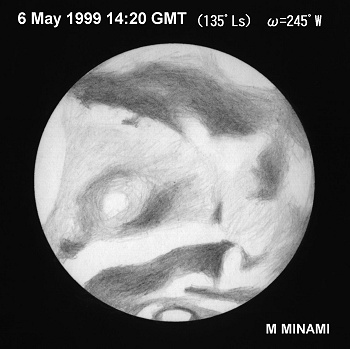

At the beginning of May 1999, we observed that following the morning Utopia there appeared a conspicuous morning white mist, and sometimes the mist floated into the inside of Utopia. We readily reported about this phenomenon in CMO #218 at p2519: Our observations started from 5 May (134°Ls ), and p2514 shows a schematic diagramme of the phenomenon.
@ We became aware at the end of May that the HST worked on 6 May (135° Ls) from 11:28 GMT (LCM=203° W) to 12:22 GMT (LCM=217°W). As seen from the list below, on the day we observed in Japan starting from 10:00 GMT (LCM=182°W, by Nj), and hence we were near the telescopes when the HST was active on Mars. We cite here the HST original images at 225 nm and 631 nm, and a composed image. In the Ultra-Violet, the mist looks thick inside Utopia, though invisible in Red light.
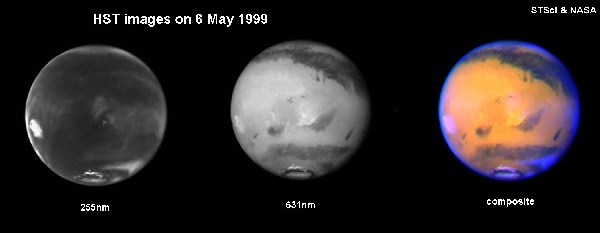
@ This phenomenon was no mere morning mist, but it was worthy of notice because the mist varied every day and sometimes invaded deep inside of the dark area of Utopia; as shown in a drawing by Mn on 6 May cited from "Ten-Mon-Nenkan 2000" (this was taken two hours later from the HST time).
@ We here describe a trend of the mist more minutely: On 5 May we saw a bit of a dull mist near the terminator when the western part of Utopia was coming to the disk at LCM=187°W and it became thick at LCM=197°W, and on 7 May it was only a bit at LCM=188°W and not yet so developed even at LCM=195°W, while the morning Utopia mist on 11 May was already seen even at LCM=148°W, and at LCM=177°W it was bright though small and at LCM=187°W it appeared very bright and thick. On 12 May it was also conspicuous at LCM=168°W.
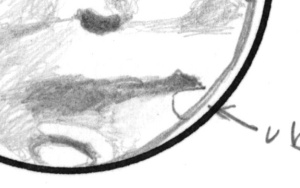
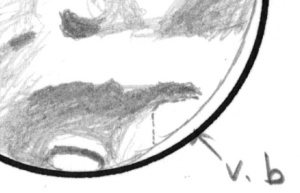
@ Note that the summit of the dark area of Utopia is at longitude=278°W. The phase angle was 10° at that time, and so the summit received the daybreak when the LCM was about 200°W; and hence the morning area seen at LCM=190°W is just the east of the summit.
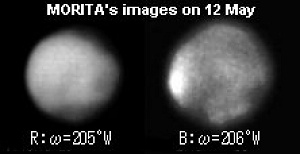 @ Another key angle is therefore about LCM=205°W, and the angle was observed from 5 May and the morning mist patch was vividly seen from this angle as well as on 6 May. It was rather weak on 7 May but was always visible up until 13 May. See MORITA (Mo)'s images. His image on 12 May is good. The mist patch looks brightest at around LCM=205°W.
@ Another key angle is therefore about LCM=205°W, and the angle was observed from 5 May and the morning mist patch was vividly seen from this angle as well as on 6 May. It was rather weak on 7 May but was always visible up until 13 May. See MORITA (Mo)'s images. His image on 12 May is good. The mist patch looks brightest at around LCM=205°W.
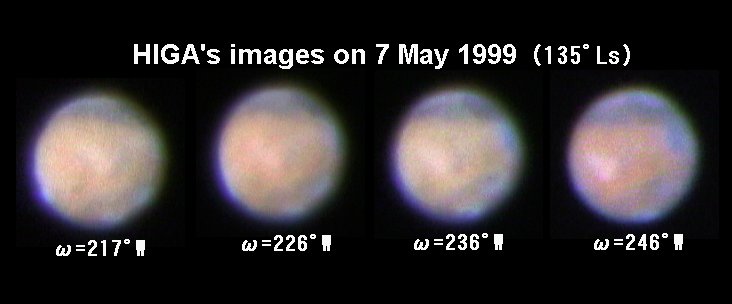
@ The morning mist varied: it sometimes remained near the terminator, it sometimes became blurred, and sometimes became absorbed into the global terminator morning mist. On 6 May, it became a thick-misty belt along the East-West direction and came into the inside of Utopia. At the same time the western tail of Utopia was darkly seen (cf also the Red image by the HST), but the dark tail in the morning appeared faint on 7 May, and a bit on 8 May, while it was unseen covered by the morning mist patch on 9 May. On 12 May, the area was not traced from our territory.
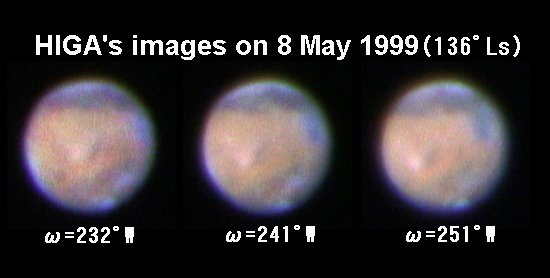
@ We suffered from bad weather from 2 May to 4 May, and on 1 May the planet was quite low when the area became present on the disk, but we can say that the bright mist at Utopia seen for example on 7 May (135°Ls) at LCM=225°W was not noticeable on 1 May (132°Ls): At Fukui we started from LCM=228°W, and AKUTSU (Ak) obtained CCD images at LCM=235°W where no mist seen near Utopia. Another evidence that the mist disturbance occurred after 1 May was given by the whole lot of excellent images by Don PARKER (DPk) made at the end of April (reported in #217): (for example; 24 April)
@ His images range as follows:
20 Apr(127°Ls)LCM=224°W,240°W 21 Apr LCM=218°W,228°W,241°W,253°W 22 Apr LCM=222°W,226°W,229°W 24 Apr LCM=187°W,192°W,197°W,211°W,220°W 27 Apr(130°Ls)LCM=156°W,162°W,170°W,179°WAs readily seen these are the angles we met at the beginning of May, and none of these shows any bright mist patch near or on Utopia. So we may conclude that the phenomenon was conspicuous from 134°Ls.